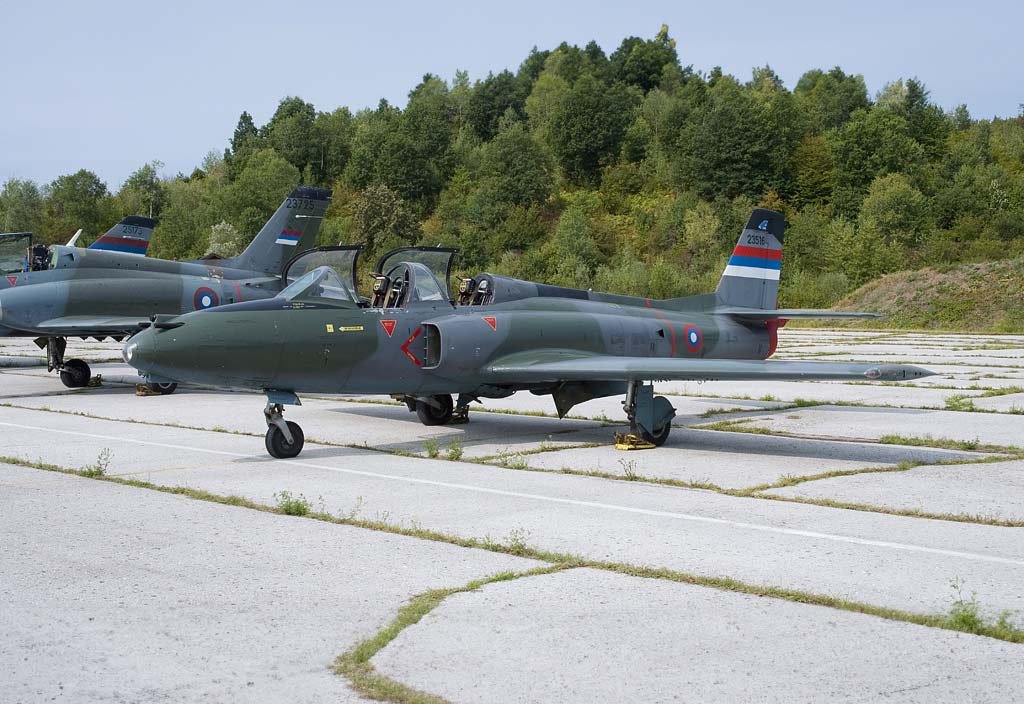The SOKO J-21 Jastreb is a Yugoslav single-engine, light attack aircraft known for its robust design and versatile performance.
In brief
The SOKO J-21 Jastreb, developed in Yugoslavia, served as a light attack and ground support aircraft, playing a key role in the Yugoslav People’s Army. Introduced in the 1960s, it was designed for close air support, reconnaissance, and training missions. The Jastreb was notable for its straightforward, durable design, featuring a single Rolls-Royce Viper turbojet engine, straight wings, and the capacity to carry a range of armaments, including rockets, bombs, and machine guns. It was appreciated for its ease of maintenance, operational flexibility, and effective ground-attack capabilities, serving primarily in the Balkans but also exported to several African countries.

History of the Development of the SOKO J-21 Jastreb (Hawk)
The development of the SOKO J-21 Jastreb reflects the Yugoslavian military’s post-WWII strategy to establish a self-reliant defense industry, reducing dependency on foreign arms. The Jastreb was conceptualized in the late 1950s as Yugoslavia sought to modernize its air force and replace older aircraft with a domestically produced, versatile light attack aircraft that could perform close air support, reconnaissance, and advanced training roles.
The design and development were undertaken by the SOKO aviation company, leveraging Yugoslavia’s expanding aviation industry. The program aimed to create an aircraft that was simple to produce, maintain, and operate, aligning with Yugoslavia’s strategic doctrine emphasizing self-sufficiency and adaptability. The J-21’s first flight was in 1965, and it quickly progressed into production due to its successful design and performance metrics.
Although the Jastreb does not have a widely recognized NATO nickname, its operational use was significant for Yugoslavia, demonstrating the country’s capability to develop and produce military aircraft independently. The Jastreb’s inception was part of a broader Yugoslav effort to enhance national defense and project technological prowess during a period marked by Cold War tensions and Non-Aligned Movement politics.
Design of the SOKO J-21 Jastreb (Hawk)
The SOKO J-21 Jastreb’s design emphasized simplicity, durability, and multi-role capability. Its airframe was straightforward yet robust, featuring straight wings conducive to stable flight characteristics, especially at low altitudes crucial for its ground-attack role. The aircraft was powered by a single Rolls-Royce Viper turbojet engine, offering a balance between performance and maintenance simplicity.
The cockpit was designed for a single pilot, with an emphasis on clear visibility and ease of control, which was vital for its close air support missions. The Jastreb could carry a variety of weapons, including machine guns, bombs, and unguided rockets, housed under its wings on hardpoints. Its avionics were basic yet functional, aligning with its role as a cost-effective and reliable attack aircraft.
Despite its strengths, the Jastreb’s straightforward design meant it lacked the advanced avionics and systems found in more contemporary Western designs. However, its cost-efficiency, ease of maintenance, and operational versatility were highly valued, especially in the context of Yugoslavia’s strategic and economic environment.
Performance of the SOKO J-21 Jastreb (Hawk)
The J-21 Jastreb was powered by a Rolls-Royce Viper Mk 22-6 turbojet engine, enabling a maximum speed of around 750 km/h (466 mph) and a service ceiling of 12,000 meters (39,370 feet). Its range was approximately 1,000 kilometers (620 miles), sufficient for short-range missions typical of its operational roles.
The aircraft’s performance was tailored to low-altitude flight, providing excellent handling and stability for ground-attack missions and close air support. Its engine and aerodynamic design facilitated a reasonable thrust-to-weight ratio, ensuring respectable acceleration and climb rate, which were critical for evading ground-based air defenses.
When compared to contemporaries like the Cessna A-37 Dragonfly or the BAE Hawk, the Jastreb held its own in terms of ruggedness and low-operating costs, though it generally lacked the advanced avionics and higher performance characteristics of Western models.
Variants of the SOKO J-21 Jastreb (Hawk)
The SOKO J-21 Jastreb was developed into several variants, each tailored for specific roles while maintaining the core design philosophy of the aircraft:
- J-1 Jastreb: The initial production version designed primarily for ground-attack missions, equipped with hardpoints for a variety of weapons and fitted with basic avionics for daytime operations.
- J-1E Jastreb: An export version of the J-1, which included slight modifications based on the requirements of foreign users. This variant retained the ground-attack capabilities and was adaptable to different armament configurations.
- J-22 Orao: While not a direct variant of the Jastreb, the J-22 Orao was a subsequent development that shared some design elements with it. The J-22 was a twin-engine, supersonic ground-attack and reconnaissance aircraft developed in cooperation with Romania, representing a significant advancement from the Jastreb.
- RJ-1: A reconnaissance variant equipped with cameras and other sensors in place of armament, designed for tactical reconnaissance missions.
- NJ-1: A two-seat trainer version that maintained the combat capabilities of the single-seater, allowing for advanced training in weapon systems and combat flight operations.
Each variant ensured the Jastreb’s adaptability to different mission requirements, extending its service life and operational utility.

Military Use and Combat of the SOKO J-21 Jastreb (Hawk)
The SOKO J-21 Jastreb served primarily with the Yugoslav Air Force, where it was used extensively as a ground-attack aircraft. Its military significance was highlighted during the Yugoslav Wars in the 1990s, where the Jastreb was deployed in combat operations. It conducted close air support and ground-attack missions, demonstrating its capabilities in a real-world conflict environment.
The Jastreb was armed with a combination of machine guns, bombs, rocket pods, and later, guided missiles, making it a versatile platform for a variety of ground-attack missions. Its operational use in the Balkans provided valuable data on its performance in combat, showcasing its effectiveness and reliability under challenging conditions.
During the conflicts, the Jastreb faced anti-aircraft fire and potential air-to-air threats. Some aircraft were lost due to ground fire, underscoring the hazardous nature of the close air support missions they were undertaking. Despite these losses, the Jastreb proved to be a robust and effective ground-attack aircraft.
The aircraft’s export history is limited, with its primary operator being the Yugoslav and subsequently the Serbian Air Force. The end of the Yugoslav Wars and the subsequent changes in the geopolitical and security environment of the region led to a gradual phase-out of the Jastreb from active service.
The SOKO J-21 Jastreb stands as a significant example of Yugoslavian aerospace ingenuity during the Cold War era. Designed to fulfill a specific need for a robust, reliable ground-attack aircraft, the Jastreb showcased the industrial and technological capabilities of the former Yugoslavia. Its service life, marked by operational effectiveness, adaptability to various combat roles, and a notable performance in the Yugoslav Wars, attests to its solid design and utility in the field.
Back to the Fighter Jet section.